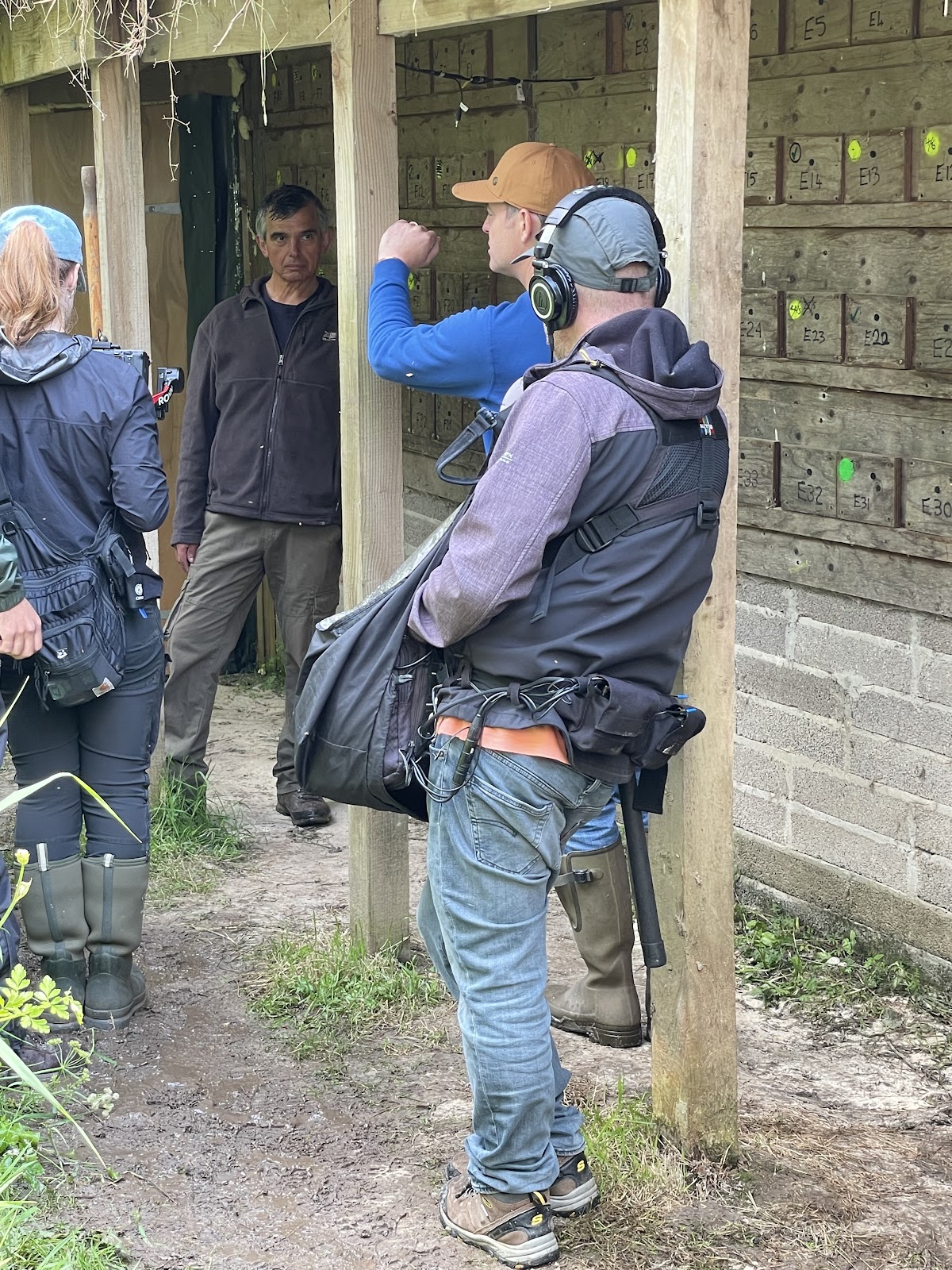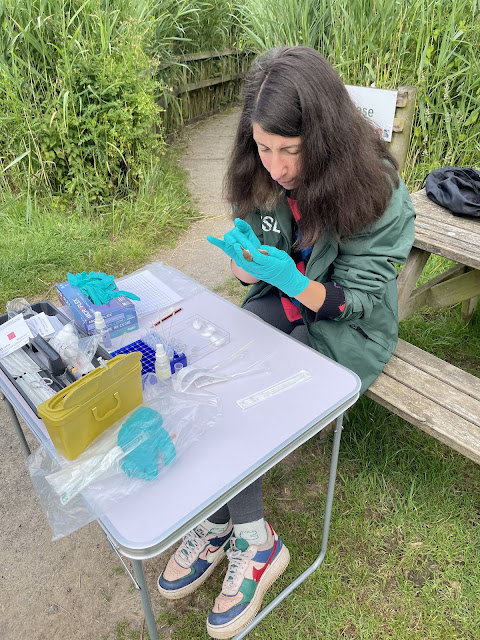We've been busy! This post will cover 3 sessions......
Firstly, on Wednesday 4th June a Sand Martin monitoring & pulli ringing session was carried out at the Sand Martin cliff. This would normally have taken place on the Thursday, but was brought forward to fit in with the Countryfile filming schedule. The episode features several activities at the Wetlands, including the Group's work at the cliff. Countryfile visited the Wetlands back in 2013 and featured Matt Baker discussing the construction of the cliff with Doug. Matt & Doug re-convened to cover the current Sand Martin activity, including a demonstration of monitoring by means of an endoscope, and the ringing of 4 broods of young.
The presenters & crew were all very friendly & it seemed to go quite well....we'll find out how it actually went when they air the episode on Sunday 22nd June!
 |
| The Mallard family was the centre of attention as it lashed down! |
 |
| Doug & Matt chatting behind the cliff |
 |
| Robin & Miriam (the ringing Team) with Sammi Kinghorn. |
On Tuesday 17th June we had the first mist netting session on the Wetlands since 12th Jan. We planned to put up 6 nets in the vicinity of the Discovery Hut. However, having put up 4, a surprisingly large number of birds blundered into the nets & we didn't get around to putting up the last 2.
We set up base on the picnic bench below the Discovery Hut, & were joined by Mariana, a researcher from the Zoological Society of London. Mariana is part of the 'VB-RADAR' project (Vector-Borne Real-time Arbovirus Detection & Response), which aims to improve understanding of diseases of wild birds which are spread by mosquitoes & which may in rare cases transmit to humans. In particular, Mariana was sampling for Usutu virus & West Nile virus. There are particular species being targeted, including Blackbirds which are susceptible to Usutu virus with a resultant decline in infected populations. A later post will go into more details of the project, but it's great that the Group is getting involved in such important research.
 |
| Ringing & sampling base |
 |
| Mariana taking samples from a Reed Warbler |
Our nets were set up behind the Discovery hut, with 3 around the reed bed. We were amazed at the number of adult Reed Warblers we caught from such a small area, with only 6 of the 25 being this year's birds, and they were all caught quite late in the session. Of the adults, 2 were re-traps, with one having been ringed as a a young bird on 31/7/2018, making her almost 7 years old! Not bad when the average age is 2 years.
We did have plenty of other juvenile birds that will have bred nearby, with Chiffchaff, Cetti's Warbler, Dunnock, Blackbird and a large family of recently fledged Blue Tits.
 |
| Young Reed Warbler (Age code 3J) |
 |
| Young Dunnock (Age code 3J) |
We also caught a Sand Martin....just the one.
 |
| Adult Sand Martin (Age Code 4) |
| Ringed | Re-trapped |
House Sparrow | 2 |
|
Reed Warbler | 23 | 2 (3/7/18, 19/5/22) |
Blue Tit | 12 |
|
Chiffchaff | 2 |
|
Dunnock | 1 |
|
Sand Martin | 1 |
|
Cetti’s Warbler | 1 | 1 (9/1/25) |
Blackbird | 1 |
|
| 43 | 3 |
We wondered if we'd see the Sand Martin again at our next session planned for 2 days later, when we were going to attempt to catch adults at the front of the Sand Martin Cliff. After taking down the nets, we spent quite a long time making plans & preparing for the attempt, something we'd never tried before.
On Thursday 19th June we re-convened at the Discovery Hut at 5am. We put up two 30m nets on the grass near to the Sand Martin cliff, and walked them in open. As we walked in front of holes, the birds started to fly out straight into the nets. Ensuring that the net was kept tight & the birds held well above the water, we used umbrella bases to hold the poles upright on the concrete path that runs in front of the cliff.
 |
| The nets being erected in front of the cliff. |
 |
| Sand Martins being extracted after the initial catch. |
 |
| Sand Martin adult (Age Code 4) |
 |
| Sand Martin juvenile (Age code 3J) |
 |
| Comparison of heads, Juv at top. |
We were surprised by how few ringed juveniles we caught considering how many pulli (nestlings) had been ringed in the cliff....230 to be precise. All the youngsters were caught quite late in the session, and of the 5 young birds we did catch, 3 were ringed during the filming of the Countryfile episode! The others were ringed on 25/5 & 29/5.
We also caught 2 ringed adults, and were very excited to find that they were both controls ie not ringed at the Wetlands, & in fact both had been ringed in France! The details of when & where they were ringed will be posted when we know.
Unsurprisingly considering that both females & males incubate, most of the adults had brood patches, although the female brood patches are more comprehensive.
 |
| Female Sand Martin brood patch |
We did continue to catch a few birds in the net after the initial catch. The net was only left up for an hour so as not to prevent free access to the cliff for too long. The net was far enough from the wall that birds could continue to access the holes even with it open by going over the top, & they even used the net as a perch!
 |
| Birds perching on the net strings! A few occasionally toppled in & were quickly extracted. |
It had been a very successful 1st attempt to catch the adults!
Sand Martins | Ringed | Re-trapped | Control | Total |
Adults (4) | 50 |
| 2 | 52 |
Juveniles (3J) | 9 | 5 |
| 14 |
Totals | 59 | 5 | 2 | 66 |
 |
| The happy Team! |






























